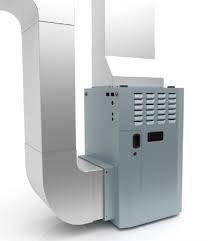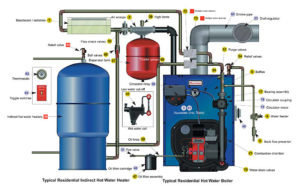One of the most common sources of confusion for the HVAC beginner is, “Is it a furnace or a boiler?” There is a difference between the two. I will attempt to clear the confusion so you can seem super smart, but just in case I leave you more confused than before, here’s a tip: when in doubt, just say, “my heating system” and then you’re covered!
So, are you ready for the big reveal? OK, here goes:
A furnace heats air.
A boiler heats water.
That’s the big difference. Problem solved. Right? Nah. There’s no way it’s that easy. So…how do you know if your heating system is heating water or air?

Well, let’s start simple. Do you have ductwork? Does your ductwork blow warm air out in the winter? If it does, you probably have a furnace. I say probably because there are heat pump style HVAC systems that use a “reverse refrigeration” process that allows the same unit you use for air conditioning, to do a little switcheroo (that is the technical term, by the way) and also produce heat. I know! Mind. Blown. Anyway, heat pumps also use ductwork to blow out warm air, but are not considered furnaces. There are also some commercial systems that use air handlers to blow air through the building that was actually heated by warm water coils within the air handler. So again, it’s blowing warm air through ductwork, buuuut the warm air was heated by water from a boiler, not a furnace. So the warm air from your ducts thing is not 100% indicator of furnace. Darn.
Let’s see if boilers are easier… In most homes, a boiler would heat the house using baseboards that have water piping inside of them. The warm water moves through the pipes and uses fins to distribute the heat from the water into the air of the room. In older homes, you often see warm water radiators instead of baseboards – those iron beasts that are sometimes gorgeous, but most times very big utilitarian beasts. Or, if you’re REALLY lucky, you have my personal favorite, underfloor radiant heat which uses warm water from your boiler to heat your floor and radiate warmth into your room from the floor up. This is especially delightful because you not only have toasty toes, you also have a room that is warmest where you need it most, near the floor, where you are. Unfortunately, just the presence of a baseboard/radiator/underfloor heat isn’t 100% indicator of a boiler. There are baseboards, radiators and underfloor radiant heat systems that use electricity instead of water, so just because you have one of these, it does not necessarily mean you have a boiler. Darn, darn!

Using the generic term, “heating system” sounds more attractive now, doesn’t it? You know what else stinks? Most HVAC units look about the same from the outside. Big metal boxes. It’s what’s inside and how they operate that defines what they are called. And just to make things extra fun, there are often multiple terms for the same unit. Ugh! But I promised to attempt to make this clear and easy right?
So, assuming you have a simple system, go into your basement/utility room/etc. wherever your heating system is. Look at what is going into and coming out of the metal box that is your heater. Is it ductwork? Ductwork = air = furnace. Or is it pipes? Pipes = water = boiler. If your system is NOT simple, well then I’m sorry to say that it might take a trained eye to get it right. Some systems are so darn complicated and customized that the only way to know what it does is to look up the model and serial number with the manufacturer! And that is reason #7,642 why it’s important to find a qualified HVAC contractor that you can trust.
So, did I help or make it worse?
